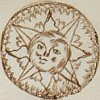"The Codex canadiensis is a 79-page document written circa 1700. Illustrated with 180 drawings, it describes the First Nations, plants, mammals, birds and fish of Canada."
 The background to this manuscript is a little mysterious - nothing at all is known of its history prior to 1930 when a facsimile edition was published in France. Around this time the oil magnate Thomas Gilcrease purchased the original work and eventually donated it to the Gilcrease Museum in Tulsa, Oklahoma where it still remains.
The background to this manuscript is a little mysterious - nothing at all is known of its history prior to 1930 when a facsimile edition was published in France. Around this time the oil magnate Thomas Gilcrease purchased the original work and eventually donated it to the Gilcrease Museum in Tulsa, Oklahoma where it still remains. There has been a lot of speculation over the authorship of the manuscript with the current position being that it comes from Louis Nicolas, a somewhat renegade Jesuit priest, who spent 11 years in Canada as a missionary and languages expert, from 1664. However, it is not his hand that actually produced the Codex - he died in 1682 - it is said to have been written/drawn by a colleague who knew his work well.
There has been a lot of speculation over the authorship of the manuscript with the current position being that it comes from Louis Nicolas, a somewhat renegade Jesuit priest, who spent 11 years in Canada as a missionary and languages expert, from 1664. However, it is not his hand that actually produced the Codex - he died in 1682 - it is said to have been written/drawn by a colleague who knew his work well.Library and Archives Canada, in partnership with the Gilcrease Museum and the Gail and Stephen A. Jarislowsky Institute for Studies in Canadian Art have launched a brand new website devoted to Codex canadiensis. There is ample commentary and both an html and a flash turn-the-pages presentation.
[via David Mattison's The Ten Thousand Year Blog - a site devoted to digital preservation, particularly as it pertains to Canada]
{I've touched up the background in some of the above images. Most are details. Click the map and the last 2 images for much larger versions - which come from the 'What is Codex canadiensis?' section of the site}


































3 comments :
I've been enjoying your blog for quite some time. Thought you might find the work of ernst haeckel interesting.
http://en.wikipedia.org/wiki/Kunstformen_der_Natur
Mmm...I didn't quite do Haeckel the justice he deserves. Cheers.
Chris I hadn't noticed until you mentioned it and you're referring to the beastie below the map in the first picture I'm presuming. Good call.
Icythosaur. They were certainly described after this manuscript was concocted. I thought it looked like a platypus-o-crocodile.
A lot of the drawings were derived from or influenced by Gesner's Historia Animalium which is full of fanciful creatures.
Post a Comment
Comments are all moderated so don't waste your time spamming: they will never show up.
If you include ANY links that aren't pertinent to the blog post or discussion they will be deleted and a rash will break out in your underwear.
Also: please play the ball and not the person.
Note: only a member of this blog may post a comment.